![]()
![]()
![]()
Use LEFT and RIGHT arrow keys to navigate between flashcards;
Use UP and DOWN arrow keys to flip the card;
H to show hint;
A reads text to speech;
59 Cards in this Set
- Front
- Back

ID # 5, 3, & 11 |
5- stage 3- objective lens 11- fine focus |
|
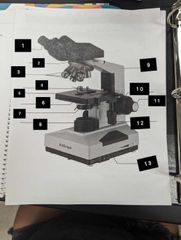
ID 6, 2, 9, & 12 |
6- condenser lens 2- revolving nose piece 9- arm 12- mechanical stage control knob |
|
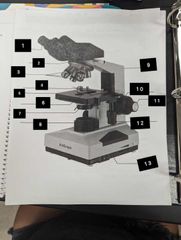
ID 1, 7, & 13 |
1- ocular lens 7- Iris diaphragm 13- base |
|
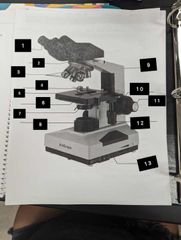
ID 4, 8, & 10 |
4- mechanical stage 8- light source 10- course focus |
|
|
ID the 8 safety features of the lab room |
1- lab phone 2- eye wash station 3- first aid kit 4- PPE 5- broken glass or biohazard container 6- lab trash can, broom, and dustpan 7- exits 8- fire blanket and extinguisher |
|
|
Identify best practices for when things go wrong - fire |
Tell your instructor immediately. Emergencies, call campus security 2911 or 911 Fire, fire blanket or extinguisher, or exit room and either exit the building to the left or to the right across the hall then meet in the north parking lot. |
|
|
Identify best practices for when things go wrong - cuts or burns |
Tell your instructor immediately.Emergencies, call campus security 2911 or 911Cuts or burns, minor- rinse and treat major- go to a medical facility |
|
|
Identify best practices for when things go wrong - spills |
Tell your instructor immediately.Emergencies, call campus security 2911 or 911Spills, clean up immediately, wash it off if it's on you, and report it! |
|
|
Identify best practices for when things go wrong - broken glass or waste materials |
Tell your instructor immediately.Broken glass or waste material, clean up and put in biohazard or sharps container. |
|
|
Identify the standard units of measurement in the metric system Mass, pounds = ? |
Grams |
|
|
Identify the standard units of measurement in the metric system Length, feet = ? |
Meters |
|
|
Identify the standard units of measurement in the metric system Volume, quarts = ? |
Liters |
|
|
Identify the standard units of measurement in the metric system Temperature, Fahrenheit = ? |
Celsius |
|
|
Which direction does the decimal point move when converting from a smaller unit to a bigger unit |
Left |
|
|
Which way would you move the decimal when going from a bigger unit to a smaller unit |
Right |
|
|
Meter to centimeter |
Two decimal points |
|
|
Meter to kilometer |
Three decimal points |
|
|
Meter to millimeter |
Three decimal points |
|
|
Millimeter to centimeter |
One decimal point |
|
|
125 m to km |
0.125 km |
|
|
125000 m to km |
125 km |
|
|
22500 cm to m |
225 m |
|
|
2.25 m to cm |
225 cm |
|
|
0.065 m to mm |
65 mm |
|
|
6.5 cm to mm |
65 mm |
|
|
How do you carry a microscope? |
Both hands, upright, hold arm and base |
|
|
Identify the powers and names of the objective lenses |
Scanning lens, power 4x Low power lens, power 10x High power lens, power 40x Oil immersion lens, power 100x |
|
|
Calculate total Magnification |
Power of objective lens × power of ocular (10x) |
|
|
Identify depth of fields relationship with magnification |
The more magnification the less of the subject you see within the depth of field |
|
|
Define parfocal |
Only needing minor fine focus adjustments between objective lenses |
|
|
What is the difference between prokaryotic and eukaryotic cells? |
Eukaryotic cells - have a nucleus and membrane bound organelles (larger) Prokaryotic cells - do not have a nucleus or membrane-bound organelles (smaller) |
|
|
Describe how to ID an onion cell at 400 total magnification |
Includes cell wall, cell membrane, and central vacuole Looks like an empty (central vacuole) cell |
|
|
Describe how to ID an elodea leaf cell at 400 total magnification |
Includes cell wall, cell membrane, chloroplasts, and cytoplasm Looks like a cell with a little green dots (chloroplasts) floating around inside clear (cytoplasm) cells. |
|
|
Describe ways to ID frog skin cells at 400 total magnification |
Includes nucleus and cytoplasm Looks like little purple dots (nucleus), floating in pink (cytoplasm) |
|
|
Found on the outside of the cell and provides a " box" within which the rest of the cell is found |
Cell wall |
|
|
Located inside the cell wall and outside the cytoplasm. Very thin and in plant cells it is pressed up against the cell wall making it difficult to see. |
Plasma membrane, aka cell membrane |
|
|
Appears as a round structure in the center of the cell with small structures seen inside |
Nucleus |
|
|
Appears as a granular material near the cell wall, a very thin layer. |
Cytoplasm |
|
|
A large, water filled space towards the center of the cell. Appears to be empty, due to being full of water. |
Central vacuole |
|
|
Used for movement, attached to the outside of the cell wall. |
Flagella or cilia |
|
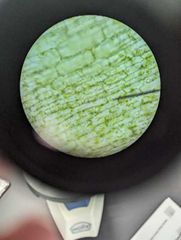
|
Elodea leaf |
|
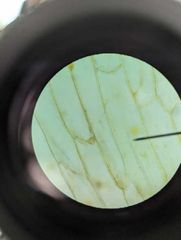
|
Onion cells |
|
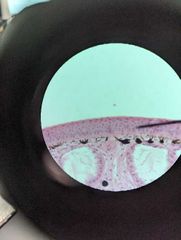
|
Frog Skin |
|
|
How to identify plant cells? |
Contains chloroplasts, cell wall, multicellular, autotrophs |
|
|
How to identify fungi? |
Contains cell wall, no Chloroplasts, multicellular, heterotrophs |
|
|
How to identify animal cells? |
No Chloroplasts, no cell wall, multicellular, heterotrophs |
|
|
How to identify protists? |
Unicellular, Don't fit in any other category, mixotrophs |
|
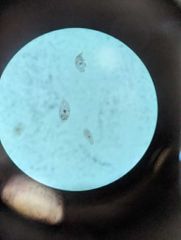
|
Euglena |
|
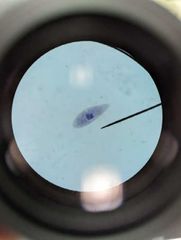
|
Paramecium |
|

What is special about these cells? |
Cyanobacteria (prokaryotic) |
|
|
ID the components of a solution |
Solutes- dissolved substances Solvents- dissolving agent (substance in which the solute is dissolved) |
|
|
Define diffusion |
Movement of a solute spreading out evenly into the available space |
|
|
Define osmosis |
Passing of a solvent through a semi-permeable membrane |
|
|
Diffusion moves in what direction? |
From where I solute is to wear a solute isn't |
|
|
Osmosis moves in what direction? |
From area of high concentration of solvent to area of low concentration of solvent |
|
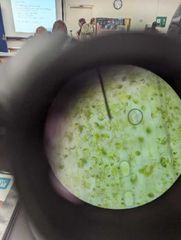
Hypertonic or hypotonic? |
Hypertonic |
|
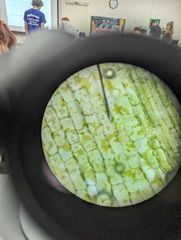
Hypertonic or hypotonic? |
Hypotonic |
|
|
Plant cell that is dehydrated, chloroplasts and central vacuole all shriveled in the middle of the cell. |
Hypertonic |
|
|
Plant cell with excessive water, central vacuole full and chloroplasts pressed against the cell wall |
Hypotonic |

